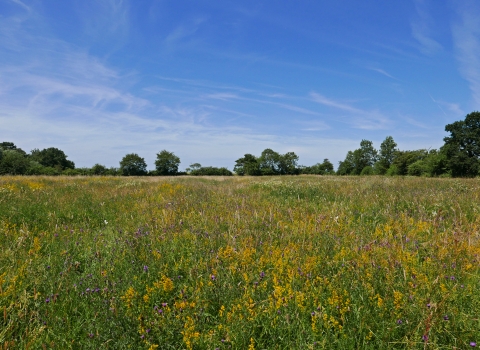Areas that were previously arable fields were enriched by continuous use of fertilisers. This has raised nutrient levels in the landscape to artificially high levels that are bad for many native wild plants. Therefore the first part of our restoration process is to remove the excess levels of nutrients. This can be achieved over several years using grass and grazing by sheep. Hay crops can also be taken from the fields and then, when water levels can be raised, cattle can be introduced into the wildlife-rich wet pasture. Grazing animals help improve the diversity of wildflower species by providing areas of open soil for seeds to set into and reducing the dominance of bulky species.
Stage 1: Grass fields (1-2 years)
The first stage of restoration is to plough and roll the arable fields ready for seeding. The fields are then planted with grass seed to help control weeds and bind the fine peat soil. At this stage there is not a wide variety of plants to attract lots of wildlife, but there are brown hares, skylarks and occasional lapwings in the winter.
Stage 2: Hay meadows and grazing (1-5 years)
After the summer, hay crops are harvested. Removing hay helps to take nutrients from the soil. It also benefits the farming industry by providing high quality livestock feed. Later, sheep are introduced to graze the fields. By eating the coarser grasses, sheep help wildflowers and other plants to grow.
Fields at this stage are good for small mammals such as voles and shrews, attracting hunting owls and kestrels. Meadow pipits and corn buntings like the tussocky, longer grass for nesting and they feed in short grass.
Stage 3: Wet meadows
In some areas, dry meadows will remain indefinitely and pockets of scrub and woodland will be allowed to develop. However, many fields will be changed into wet meadows so the water levels below the surface need to be be raised. Raising the water level creates more moisture and some shallow pools begin to form, particularly in the winter.
At this stage grazing is suitable for cattle rather than sheep and they naturally create deeper pools and areas of shorter and longer grass for wildlife. These wet meadows are a perfect habitat for nationally declining birds such as lapwing and snipe whose chicks need moist ground in which to find insects.
